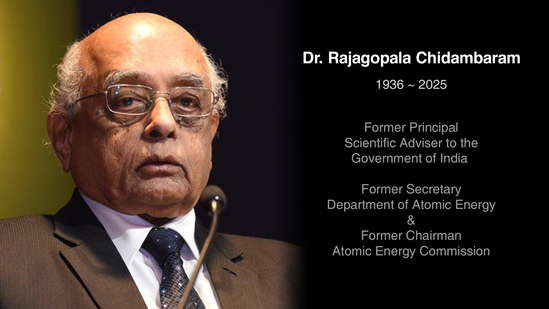Important Facts For Prelims
India’s Nuclear Programme
- 04 Feb 2025
- 5 min read
Why in News?
Eminent physicist, scientist, former Chairman of the Atomic Energy Commission (AEC) and a key architect of India’s nuclear programme Dr. Rajagopala Chidambaram recently passed away.
Key Contributions of Dr. Rajagopala Chidambaram
- Scientific Achievements: Solved the "equation of state" for plutonium (1967), advancing nuclear fission and materials science.
- Led India’s indigenous supercomputer development.
- Leadership in Nuclear Tests: Smiling Buddha (1974) and Operation Shakti (1998).
- Key Positions: Director of BARC, Chairman of Atomic Energy Commission (AEC), Chairman of IAEA Board of Governors.
- Principal Scientific Advisor (2002-2018), overseeing initiatives like RuTAG and National Knowledge Network (NKN).
- Awards: Padma Shri (1975) and Padma Vibhushan (1999) for contributions to science.
What is India's 3-Stage Nuclear Power Programme?
- About: India's 3-Stage Nuclear Power Programme is designed to harness the nation's nuclear resources for sustainable energy production while ensuring long-term energy security. It was formulated by well-known physicist Dr. Homi Bhabha.
- Objective: It focuses on efficiently using India's limited uranium resources while maximizing the potential of thorium, which is more abundant in the country.
- 3 Stages:
|
Stage |
Aim |
Fuel/Coolant/ Moderator |
Nuclear Reactor |
Current Status |
|
Stage 1 |
It aims to generate electricity while producing plutonium-239 (Pu-239) as a byproduct.
|
Fuel: Uranium (U-238) Moderator: Heavy water (deuterium oxide) |
Pressurized Heavy Water Reactors (PHWRs) |
India has already constructed 18 PHWRs, as the foundation of India's nuclear power infrastructure.
|
|
Stage 2 |
It focuses on Fast Breeder Reactors (FBRs), which utilize Pu-239 from the first stage to generate more fissile material than they consume.
|
Mixed Oxide of Plutonium-239 and Uranium-238 |
Fast Breeder Reactors (FBRs)
|
The Prototype FBR at Kalpakkam, Tamil Nadu, is a key development in this stage. |
|
Stage 3 |
It focuses on Thorium Reactors, which use Thorium-232 to produce uranium-233, a fissile material.
|
Thorium-232 (converted into Uranium-233)
|
Thorium-Based Reactors (Thorium Cycle) |
Research into thorium-based reactors is ongoing, with the Advanced Heavy Water Reactor (AHWR) being developed as part of this stage.
|
India Nuclear Weapon Programme
- Smiling Buddha (1974): Smiling Buddha was the codename of India's first successful nuclear test, conducted at Pokhran in Rajasthan, marking India as the sixth nuclear-capable nation after the US, Soviet Union, United Kingdom, France, and China.
- Operation Shakti (1998): Operation Shakti (Pokhran-II) was a series of five nuclear tests under Operation Shakti, including a thermonuclear bomb.
UPSC Civil Services Examination, Previous Year Questions (PYQs)
Prelims
Q. In India, why are some nuclear reactors kept under “IAEA safeguards” while others are not? (2020)
(a) Some use uranium and others use thorium
(b) Some use imported uranium and others use domestic supplies
(c) Some are operated by foreign enterprises and others are operated by domestic enterprises
(d) Some are State-owned and others are privately owned
Ans: (b)





